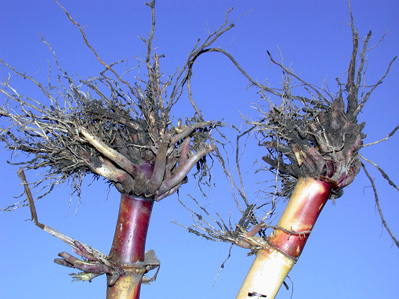• Following reports of high damage in Iowa, lab studies revealed resistance to Bt hybrids expressing Cry3Bb1 toxin (found in Monsanto hybrids targeting rootworms).
• Field locations where resistance was documented were characterized by high rootworm pressure, with a history of continuous Bt corn planting.
• This highlights the importance of refuge planting, and Indiana producers should remain vigilant.
|
|
Regular readers of Pest&Crop may recall that we have mentioned a few times that corn rootworm Bt toxins are not high dose toxins – meaning that many larvae survive exposure and reach adulthood on each acre of these hybrids.
This is one of the reasons that the refuge is so critical in stewardship of this valuable IPM tool. Those points were underscored by the publication last week of the research findings of Iowa State entomologist Aaron Gassman and co-authors.
After receiving persistent reports of high damage to Bt corn in northeastern Iowa, the group collected adults and eggs from the area. Rearing the larvae in the laboratory on Bt hybrids revealed that the larvae were able to survive on Bt corn hybrids expressing the Cry3Bb1 toxin at levels similar to survival on non-Bt corn. Hybrids expressing this toxin include those formerly labeled as Yieldgard RW and VT3 hybrids.
This toxin is also one of the proteins found in SmartStax hybrids. The good news is that the study tested the other major toxins deployed in North America against this pest, Cry34/35 (found in Herculex hybrids targeting rootworms and also in SmartStax hybrids), and no enhanced survival was found.
Although Cry3bb1 and Cry34/35 toxins are different, they are similar enough that cross-resistance (where surviving exposure to one toxin confers some level of survival to another), was a possibility worth investigating.
No evidence of cross-resistance was found in these rootworm populations. The next questions to tackle involve untangling the mechanisms behind how these insects are able to survive toxin exposure – what combination of physiological and behavioral traits are at work here? Understanding these mechanisms will undoubtedly help find solutions and plan future control technologies.
Given that other researchers have reported that Bt resistance is fairly easy to select for in the lab, we strongly suspected it was just a matter of time before we would see it in the field.
The majority of corn planted in the U.S. is Bt corn, and the Cry3bb1 toxin is the major one deployed against rootworms.
So what does this mean for other corn-producing areas, including Indiana? It certainly is not good news, but it is not a total disaster either. First off, it demonstrates again what a remarkably adaptable pest the western corn rootworm is. There is no "putting the genie back in the bottle," and resistance in these areas is a problem that won't go away.
This is an alert to keep our eyes open for similar occurrences elsewhere. However, the vast majority of Bt corn continues to perform well and be a boon for producers. The fields to watch are those where the selection pressure upon the pest is highest: namely continuous Bt corn in areas of high rootworm pressure.
Some northwestern and north-central Indiana fields may fit this description. In general, however, we have a more diverse cropping system than Iowa with a large proportion of fields rotating corn with soybeans. That helps delay resistance. Planting the recommended refuge certainly helps, and although compliance with the refuge requirements has been falling in recent years, this serves as a stark reminder of how important it is.
Finally, this research also underscores the fact that growers and consultants are not only the stewards of this technology, but they serve as the eyes and ears to report problem fields and initiate further study. None of this research would have been done without reports to Iowa State University extension staff, so please keep your eyes open and don't hesitate to report potential problems.

 Cry3Bb1 traited (left) versus untreated (right) roots from Purdue efficacy trial a few years ago. (Purdue photo)
Cry3Bb1 traited (left) versus untreated (right) roots from Purdue efficacy trial a few years ago. (Purdue photo)




Post a comment
Report Abusive Comment